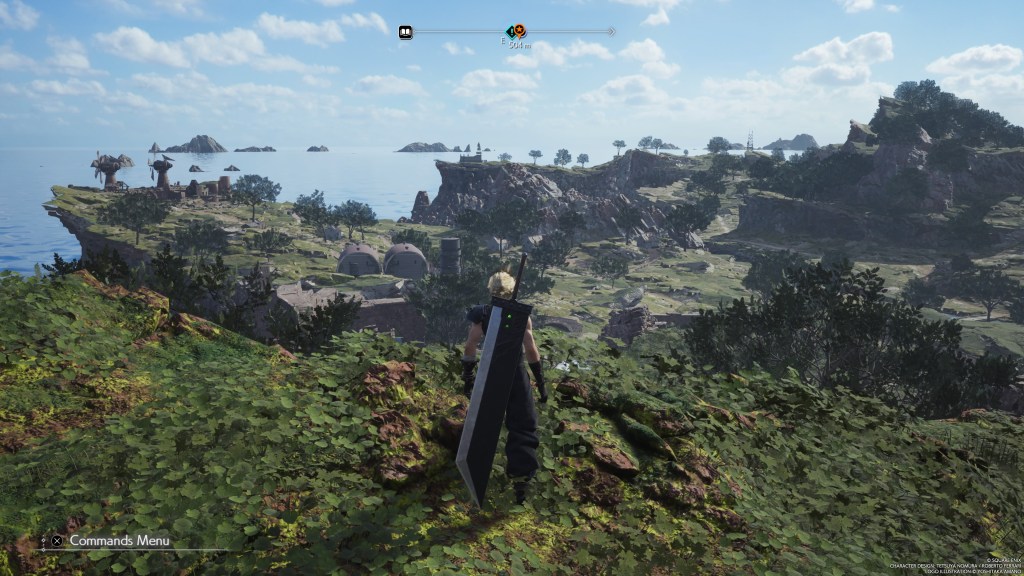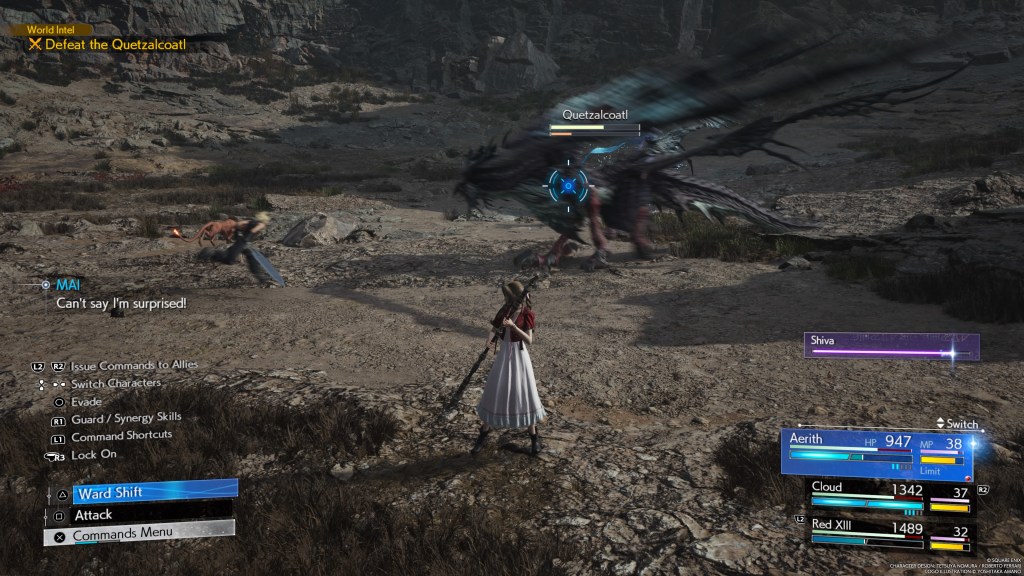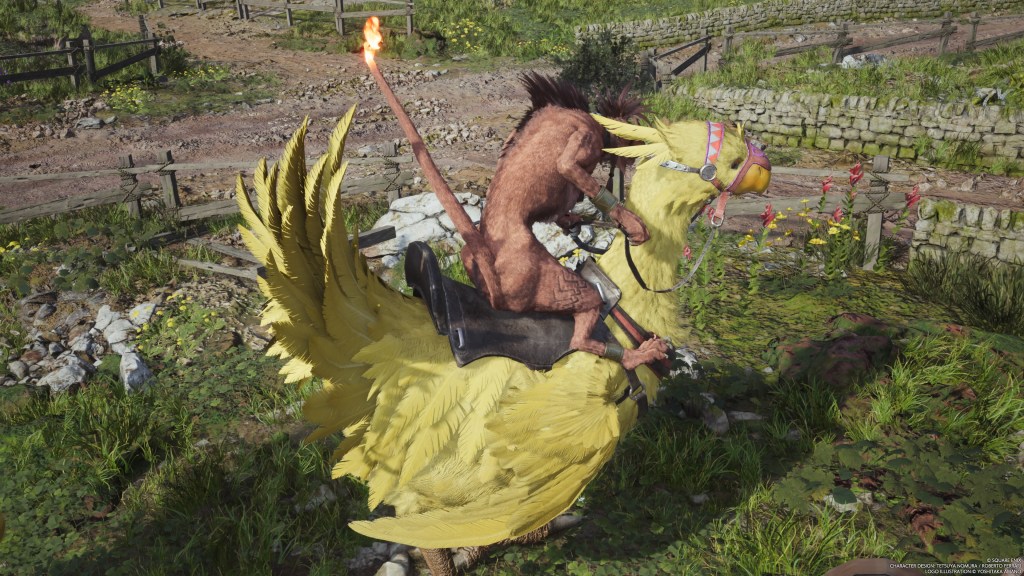It’s time to get out of Midgar. If you’re a fan of the original Final Fantasy 7, you know that game finally opens up in second half of the first disc, with Cloud and the gang setting off into the wider world of Gaia in pursuit of Sephiroth. As such, Final Fantasy 7 Rebirth is a tougher game to make as it comes with a lot of expectations, more content to recreate, and a lot of build-up from the ending of FF7 Remake. Square Enix has reinterpreted and refreshed all of the enemies, environments, and plot points while adding new, modern elements that still treat the original game with respect. The amount of work that has gone into FF7 Rebirth is truly staggering, and though several parts of the game feel stretched out and encumbered, it follows through on its potential.
The next world

This review will be purposefully vague on the storyline of FF7 Remake and FF7 Rebirth to keep spoilers to a minimum, though anyone who has played through the original game will more or less know what happens. FF7 Rebirth, as a direct sequel to FF7 Remake, comes with several lingering plot threads that are addressed throughout the story. A recap video of the events in the first game is available in the main menu in case you need a refresher.
New cutscenes, conversations, and side quests alter the original plotline enough that it still feels like a fresh take, while the general framework has mostly been kept intact. Revisiting all of the familiar story beats, while listening to modern orchestrations of familiar tunes, is delightfully nostalgic. The party worries about Cloud’s memory, Barret and Tifa want to take down Shinra, Red XIII wishes to return home, and Aerith hopes to learn more about her past. Short scenes involving another character are mainly spliced between chapters, lending an air of mystery on the overarching timeline. It’s not until the latter half of the game that events more significantly deviate from the source material, introducing various elements to the lore that weren’t there before.
The majority of the side quests and protorelic missions spread throughout each region of the world provide opportunities for the party to interact with new characters as well as NPCs from FF7 Remake. Completing these tasks, along with choosing specific dialogue options, also adds relationships points between Cloud and one of the party members. This impacts and provides more options for a particular cutscene later in the game — a mechanic which FF7 fans will recognize. The game doesn’t shy away from adding tongue-in-cheek humor either, especially when it comes to Red XIII riding chocobos and getting mad when humans treat him like a pet.
However, FF7 Rebirth has some trouble sticking the landing, particularly in the last third of the story. How some characters are integrated into the party feels like a missed opportunity and it’s done in an awkwardly deliberate way. Also, the ending reveals a lot of information, but it’s told in a tangled, murky, erratic sequence of events. While it tries to be intriguing by raising as many questions as it answers, it sacrifices clarity for the sake of complex plot structure.
Reforged in battle

Much of the real-time combat system from FF7 Remake has been carried over with a few additional mechanics like synergy skills and abilities. Hitting enemies with basic attacks builds the ATB meter and segments of this gauge can be used to cast spells, use items, and perform character abilities. Enemies also have a stun meter that builds quickly if you’re able to pressure them, typically done by exploiting their elemental weakness or evading their strikes with proper timing. Once it’s full, they become staggered for a long time during which any damage dealt is multiplied.
Each party member has different strengths, so changing which character you control during battle can be strategically useful. In fact, the story has numerous sections that force your group to split up, so you will want to be well-versed with how each character works anyway. Out of the starting party, Cloud and Tifa are strong at dealing single-target damage, Barret and Aerith have long-range attacks, and Red XIII has a multi-hit spinning attack that builds stagger and ATB quickly.
In addition, each party member has access to limit breaks as well as a synergy meter that increases every time ATB is used. This fuels powerful synergy abilities that can give two members temporarily larger ATB meters, access to higher limit break levels, or unlimited MP for a short time. Meanwhile, synergy skills can be used freely and which ones you can use depends on your current party makeup.
FF7 Rebirth provides many opportunities for character progression beyond basic leveling. Obtaining a wide variety of materia and giving them AP from battles is vital, making materia slots on weapons and armor crucial for keeping pace with enemies and bosses in the long run. Every new weapon you find allows a character to learn an ability from it permanently, and various accessories you can purchase or craft from materials can increase base stats and grant immunities to status effects. Also tracked is Party XP earned by defeating story bosses and completing minor world intel objectives on the map. As this increases in level, your party will unlock new options on their skill trees that can be learned by spending skill points.
The main weakness of the combat system is that it’s finicky on occasion. Evading homing attacks, particularly the swallow ability from land worms, is more difficult than it should be. Figuring out limit levels is tricky too since you have to learn the appropriate skill synergies on the skill tree and then track limit level increases on your own in battle. Since using items takes one ATB charge, using them in battle is a rough call when abilities and spells tend to be better options. It’s not until you earn the Item Economizer materia or have Mist potions on hand that using one is worth the action economy.
Overlapping audio is an occasional problem as well. As you explore a town, you’ll sometimes walk around a crowd of NPCs and all of them begin talking at the same time to the point that you can barely make out what they’re saying. In fiend battles on the map, a new AI character named MAI will interrupt the fight by spewing out facts about the enemy. It’s supposed to be helpful, but alongside the intense music and special effects, her dialogue is a distraction that you can’t turn off.
Gold Saucer-eyed

One of the best parts of FF7 Rebirth is seeing every environment expanded to an incredible degree. The first town of Kalm has beautifully detailed streets and shops, while the opening Grasslands region has green rolling hills, watermills, and trickling streams. Those are merely starters compared to several cities later on, like Cosmo Canyon, Costa Del Sol, and the Gold Saucer, that are even more impressive. The level of detail just in the number of objects that fill each area is incredible. This remains consistent as you progress from one chapter to the next, even as regions become more complex to navigate.
Fortunately, dealing with the rougher terrain is by and large resolved by riding a chocobo. Not only are chocobos faster than walking on foot, but they also make grabbing resources easy and can sniff out hidden treasures on the map. Much of these are materials that can be sold for gil or transmuted into items and equipment. Specific regional versions allow you to reach restricted areas as well, like mountain chocobos being able to climb the side of cliffs. You can locate chocobo stops too that give you a chance to rest and provide another point for fast travel.
On the downside, around half of all the activities on the map amount to busywork. Similar to viewpoints in Assassin’s Creed, activating remnawave towers will reveal locations of nearby points of interest. But finding every tower, life spring, summon sanctuary, fiend battle, moghouse, cache, excavation site, and more is exhausting. The chocobo stealth activity and the Moogle Mischief mini-games are especially burdensome (and the Moogles look more like koala bears for some reason). Even if you aren’t a completionist (like I am), you are encouraged to finish as much as you can to earn Party XP, purchase powerful materia from Chadley, and unlock combat simulator battles.
Otherwise, most of the mini-games are enjoyable side diversions that add a lot of flavor. Queen’s Blood, a three-lane card game that’s similar to Triple Triad from FF8, requires a lot of strategy in placing cards on the field, and there are players in every town that you can challenge. Out of all the activities at the Gold Saucer, chocobo racing is the main attraction and plays very close to Mario Kart. In addition to Chadley’s combat simulations, there are a few other arenas for more intense fights. The piano performance mini-game from the demo appears throughout the journey too. Other mini-games from the original game have been recreated here, including the Shinra Junon parade and Fort Condor. Doing well at all these games awards strong materia, weapons, and accessories, so while many of them are optional, completing them is time well spent.
Completing the main campaign and every world intel mission takes around 100 hours, more so if you decide to tackle optional content that unlocks after you finish the story. Some chapters feel stretched out more than they should be, with some levels that go on for too long and activities that repeat themselves across every region. Tying the more mundane tasks to one of the party members, similar to how side quests are done, would have helped alleviate the tedium.
Final Fantasy 7 Rebirth Final Verdict

Through its expanded story, fantastic graphics, and abundance of side activities, Final Fantasy 7 Rebirth vigorously continues the momentum from FF7 Remake. While some parts of the game are too slow or padded for the sake of content, the majority of the experience is a pleasant ride through nostalgia. It will be curious to see how progress, if any, is carried over to the next game, given all the exploration and items that you can obtain here. At any rate, FF7 Rebirth lives up to its promise as a love letter to the original game and solidly sets up the third and final title in the trilogy.
-
Revamped, nostalgic story
-
Detailed environments and reorchestrated music
-
Wealth of side activities and mini-games
-
Red XIII is a beast in combat and plays comic relief
-
Didn’t experience any crashes and bugs
-
A few characters are integrated awkwardly
-
Issues with overlapping dialogue
-
Some content is mundane, slow, or padded
Disclosure: Final Fantasy VII Rebirth PS5 code provided by publisher.













